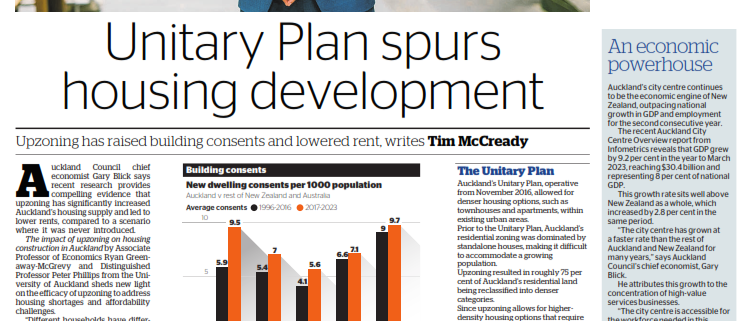Unitary Plan spurs housing development
Unitary Plan spurs housing development
Auckland Council chief economist Gary Blick says recent research provides compelling evidence that up-zoning has significantly increased Auckland’s housing supply and led to lower rents, compared to a scenario where it was never introduced.
Research on the impact of up-zoning on housing construction in Auckland by Associate Professor of Economics Ryan Greenaway-McGrevy and Distinguished Professor Peter Phillips from the University of Auckland sheds new light on the efficacy of up-zoning to address housing shortages and affordability challenges.
“Different households have different preferences, but in the main people generally want to be closer to jobs, transport and amenities — whether that is parks, schools or shops,” explains Blick.
The study, which considered the first six years since the Unitary Plan was introduced, compared parts of Auckland that were up-zoned and parts that weren’t, and used statistical analysis to determine the increase in housing development as a result.
It found strong evidence that from 2016 to 2021, almost 22,000 additional consents occurred due to the policy change.
Blick says this works out to be about 32 per cent of the total 67,000 consents over that period.
To put this into context, Blick’s own analysis shows a significant increase in dwelling consents per thousand residents since the introduction of the Unitary Plan.
In the 20 years prior to its introduction, the average number was 5.9. Since the change in policy, the average number of dwelling consents has jumped to 9.5 per thousand residents. This figure has seen Auckland surpass New South Wales and almost match Victoria.
Impact on rental prices
Blick’s analysis shows the increased housing supply may have helped limit rental price growth in Auckland.
Data from Statistics NZ’s rental price index shows that although Auckland’s rents are 22 per cent higher in nominal dollar terms since 2017, rents in New Zealand overall have grown about 50 per cent faster than Auckland over the same period.
“Research also shows that for a three-bedroom home, rents are 20-30 per cent lower than they otherwise would have been,” Blick says.
He argues that without the increased supply of housing, rental prices may have been higher, and people may have decided they couldn’t make Auckland work for them and would have chosen to leave or not come at all.
“It has given the city a better chance of holding on to some of our younger people who want to form households and of attracting people with skills who compare us with other destinations.”
Looking ahead
Blick acknowledges development under the Unitary Plan is ongoing and will require continued monitoring to assess its long-term effects.
However, these early indications are encouraging and suggest that up-zoning can be a viable strategy for addressing housing shortages. Blick says the Unitary Plan’s success is being closely observed by other cities facing similar challenges, potentially offering a valuable roadmap for tackling their own housing crises.
The Unitary Plan
Auckland’s Unitary Plan, operative from November 2016, allowed for denser housing options, such as townhouses and apartments, within existing urban areas.
Prior to the Unitary Plan, Auckland’s residential zoning was dominated by standalone houses, making it difficult to accommodate a growing population.
Up-zoning resulted in roughly 75 per cent of Auckland’s residential land being reclassified into denser categories.
Since up-zoning allows for higher-density housing options that require less land per dwelling, it allows lower development costs per dwelling and makes it more profitable for developers to build more houses, ultimately increasing supply.
An economic powerhouse
Auckland’s city centre continues to be the economic engine of New Zealand, outpacing national growth in GDP and employment for the second consecutive year.
The recent Auckland City Centre Overview report from Infometrics reveals that GDP grew by 9.2 per cent in the year to March 2023, reaching $30.4 billion and representing 8 per cent of national GDP.
This growth rate sits well above New Zealand as a whole, which increased by 2.8 per cent in the same period.
“The city centre has grown at a faster rate than the rest of Auckland and New Zealand for many years,” Blick says.
He attributes this growth to the concentration of high-value services businesses.
“The city centre is accessible for the workforce needed in this sector. Although working from home has become more of a thing, people still need to form social relationships at the workplace and engage with clients.”
Unsurprisingly, high-value services account for the largest proportion of GDP, 65.2 per cent, in Auckland’s City Centre (compared with 27.3 per cent of the national economy).
Primary industries account for the smallest proportion at 0.2 per cent (compared to 5.7 per cent in the national economy). Employment in the city centre was also up 7.3 per cent in the year to March 2023, compared with 2.5 per cent for New Zealand as a whole.
Blick acknowledges that the pandemic threw a curveball at the city centre.
“The shock really hit street-level businesses, particularly hospitality and retail, which are heavily reliant on foot traffic from tourism and students.”
Yet he remains optimistic about its long-term prospects.
“The underlying drivers of the city centre are still there,” he says, pointing to the return of tourists, students and workers and the opportunity that the City Rail Link will present. “We may have had a shock that meant that activity, population and jobs took a hit, but we’re now in a period of clawing some of that back.”



